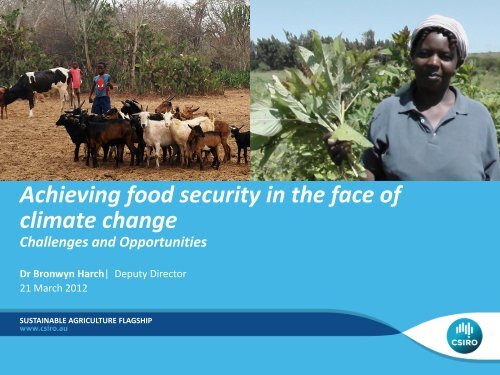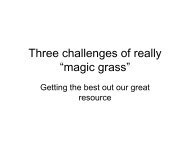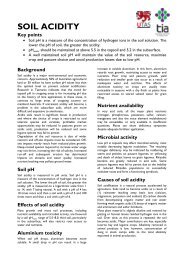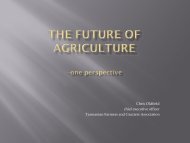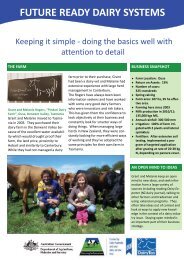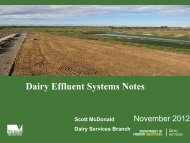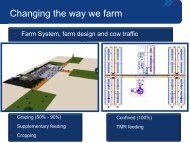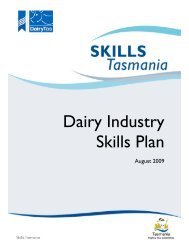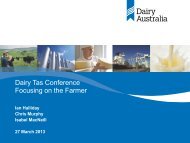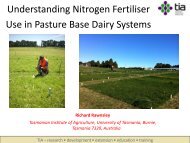Food security in the face of climate change - DairyTas
Food security in the face of climate change - DairyTas
Food security in the face of climate change - DairyTas
You also want an ePaper? Increase the reach of your titles
YUMPU automatically turns print PDFs into web optimized ePapers that Google loves.
Achiev<strong>in</strong>g food <strong>security</strong> <strong>in</strong> <strong>the</strong> <strong>face</strong> <strong>of</strong><br />
<strong>climate</strong> <strong>change</strong><br />
Challenges and Opportunities<br />
Dr Bronwyn Harch| Deputy Director<br />
21 March 2012<br />
SUSTAINABLE AGRICULTURE FLAGSHIP
<strong>Food</strong> <strong>security</strong> exists when all people, at all times, have physical, social & economic<br />
access to sufficient, safe & nutritious food to meet <strong>the</strong>ir dietary needs & food<br />
preferences for an active & healthy life.<br />
United Nations <strong>Food</strong> & Agriculture Organisation<br />
<strong>Food</strong> Security <strong>in</strong> <strong>the</strong> <strong>face</strong> <strong>of</strong> <strong>climate</strong> <strong>change</strong>| Dr Bronwyn Harch| Page 2
Key Challenges<br />
Grow<strong>in</strong>g from 7 billion people<br />
today to 9 billion by 2050<br />
1.5 billion overweight<br />
1.3 billion tonnes<br />
<strong>of</strong> food wasted<br />
each year<br />
1.5 billion depend<br />
on degrad<strong>in</strong>g land<br />
12 million ha <strong>of</strong> additional<br />
agricultural land degraded/year<br />
1 <strong>in</strong> 6 undernourished<br />
200+ million more<br />
hungry after 2007/8<br />
price spikes<br />
1.4 billion live on<br />
Photo: International Rice Research Institute (IRRI)<br />
Key Elements to <strong>Food</strong> In<strong>security</strong><br />
• Converg<strong>in</strong>g threats from<br />
<strong>climate</strong> <strong>change</strong>, population<br />
growth & unsusta<strong>in</strong>able<br />
resource use<br />
• Resource competition, land<br />
degradation & greenhouse<br />
gas emissions<br />
• <strong>Food</strong> price volatility &<br />
conflicts associated with<br />
food shortages<br />
<strong>Food</strong> Security <strong>in</strong> <strong>the</strong> <strong>face</strong> <strong>of</strong> <strong>climate</strong> <strong>change</strong>| Dr Bronwyn Harch| Page 4
Commission on Susta<strong>in</strong>able Agriculture<br />
& Climate Change<br />
• Established by <strong>the</strong> Consultative Group on<br />
International Agricultural Research (CGIAR)<br />
• Program on Climate Change, Agriculture &<br />
<strong>Food</strong> Security (CCAFS) with support from <strong>the</strong><br />
Global Donor Platform for Rural<br />
Development (GDPRD)<br />
• 13 em<strong>in</strong>ent natural and social scientists<br />
from around <strong>the</strong> world<br />
• Evidence-based policy recommendations:<br />
A ‘road map’ for policy makers<br />
Released <strong>in</strong> November 2011<br />
• Full Report be<strong>in</strong>g released 28 th March 2012<br />
http://ccafs.cgiar.org/commission/<br />
<strong>Food</strong> Security <strong>in</strong> <strong>the</strong> <strong>face</strong> <strong>of</strong> <strong>climate</strong> <strong>change</strong>| Dr Bronwyn Harch| Page 5
Photo: International Rice Research Institute (IRRI)<br />
Major F<strong>in</strong>d<strong>in</strong>gs<br />
•Bus<strong>in</strong>ess as usual will not br<strong>in</strong>g<br />
food <strong>security</strong> & environmental<br />
susta<strong>in</strong>ability<br />
•Need to simultaneously address<br />
global agriculture with<strong>in</strong> <strong>the</strong><br />
context <strong>of</strong> <strong>the</strong> food system &<br />
<strong>climate</strong> <strong>change</strong><br />
•The <strong>in</strong>terconnected nature <strong>of</strong><br />
<strong>the</strong>se challenges demands an<br />
<strong>in</strong>tegrated management<br />
approach<br />
•The world’s poor are less resilient<br />
<strong>Food</strong> Security <strong>in</strong> <strong>the</strong> <strong>face</strong> <strong>of</strong> <strong>climate</strong> <strong>change</strong>| Dr Bronwyn Harch| Page 6
Seven Recommendations<br />
1. Integrate food <strong>security</strong> & susta<strong>in</strong>able agriculture<br />
<strong>in</strong>to global & national policies<br />
2. Significantly raise <strong>the</strong> level <strong>of</strong> global <strong>in</strong>vestment <strong>in</strong> susta<strong>in</strong>able agriculture &<br />
food systems <strong>in</strong> <strong>the</strong> next decade<br />
3. Target populations & sectors most vulnerable to <strong>climate</strong> <strong>change</strong> & food<br />
<strong>in</strong><strong>security</strong><br />
4. Reshape food access & consumption patterns to ensure basic nutritional<br />
needs are met & foster susta<strong>in</strong>able eat<strong>in</strong>g habits worldwide<br />
5. Reduce loss & waste <strong>in</strong> food systems – particularly from <strong>in</strong>frastructure,<br />
farm<strong>in</strong>g practices, process<strong>in</strong>g, distribution & household habits<br />
6. Susta<strong>in</strong>ably <strong>in</strong>tensify agricultural production while reduc<strong>in</strong>g greenhouse gas<br />
emissions & o<strong>the</strong>r negative environmental impacts<br />
7. Create comprehensive, shared, <strong>in</strong>tegrated <strong>in</strong>formation systems that<br />
encompass human & ecological dimensions<br />
<strong>Food</strong> Security <strong>in</strong> <strong>the</strong> <strong>face</strong> <strong>of</strong> <strong>climate</strong> <strong>change</strong>| Dr Bronwyn Harch| Page 7
Key <strong>in</strong>sights related to<br />
Australia’s <strong>in</strong>terest <strong>in</strong> food<br />
<strong>security</strong><br />
<strong>Food</strong> Security <strong>in</strong> <strong>the</strong> <strong>face</strong> <strong>of</strong> <strong>climate</strong> <strong>change</strong>| Dr Bronwyn Harch| Page 8
Australia’s <strong>in</strong>terests <strong>in</strong> food <strong>security</strong><br />
• Australia has a high level <strong>of</strong> food <strong>security</strong><br />
o export ~60% <strong>of</strong> food production<br />
o produce 1% <strong>of</strong> world’s food; 3% <strong>of</strong> traded food<br />
• Share same health/diet issues with higher <strong>in</strong>come countries<br />
• Land and water are <strong>in</strong>creas<strong>in</strong>gly contested<br />
o food, fibre, fuel and carbon s<strong>in</strong>ks<br />
• Droughts and floods constra<strong>in</strong> ag outputs<br />
• Strong population growth is fuell<strong>in</strong>g community debate on<br />
“susta<strong>in</strong>ability”<br />
• National policy related developments and dialogue<br />
• International engagement around food <strong>security</strong><br />
DAFF 2012. FOODmap. An analysis <strong>of</strong> <strong>the</strong> Australian food supply cha<strong>in</strong><br />
<strong>Food</strong> Security <strong>in</strong> <strong>the</strong> <strong>face</strong> <strong>of</strong> <strong>climate</strong> <strong>change</strong>| Dr Bronwyn Harch| Page 9
Action <strong>in</strong> needed on three fronts<br />
1) reduc<strong>in</strong>g demand<br />
2) susta<strong>in</strong><strong>in</strong>g exist<strong>in</strong>g productivity<br />
3) fill<strong>in</strong>g <strong>the</strong> production gap<br />
<strong>Food</strong> Security <strong>in</strong> <strong>the</strong> <strong>face</strong> <strong>of</strong> <strong>climate</strong> <strong>change</strong>| Dr Bronwyn Harch| Page 10
Global <strong>Food</strong> Demand (Petacal/day)<br />
<strong>Food</strong> Demand Scenarios 1960 to 2050<br />
45<br />
40<br />
35<br />
30<br />
Plus 20 % wastage<br />
loss <strong>in</strong> value cha<strong>in</strong><br />
Plus 6 or 12 %<br />
diversion to bi<strong>of</strong>uels<br />
9B people + consumption<br />
<strong>in</strong>crease <strong>in</strong> develop<strong>in</strong>g<br />
countries<br />
25<br />
20<br />
9B people<br />
8B people , no<br />
consumption <strong>in</strong>creae<br />
15<br />
10<br />
5<br />
0<br />
1960 1970 1980 1990 2000 2010 2020 2030 2040 2050<br />
Year
Global <strong>Food</strong> Demand (Petacal/day)<br />
A ‘Mega-wedge’ <strong>of</strong> <strong>Food</strong> Demand<br />
45<br />
40<br />
35<br />
Fill<strong>in</strong>g <strong>the</strong><br />
Production<br />
Demand<br />
30<br />
25<br />
20<br />
15<br />
10<br />
5<br />
0<br />
1970 1980 1990 2000 2010 2020 2030 2040 2050<br />
Year<br />
<strong>Food</strong> Security <strong>in</strong> <strong>the</strong> <strong>face</strong> <strong>of</strong> <strong>climate</strong> <strong>change</strong>| Dr Bronwyn Harch| Page 12
Global <strong>Food</strong> Demand (Petacal/day)<br />
O<strong>the</strong>r “Mega-wedges” <strong>of</strong> <strong>Food</strong> Demand ?<br />
45<br />
40<br />
35<br />
30<br />
Fill<strong>in</strong>g <strong>the</strong><br />
Production<br />
Demand<br />
25<br />
20<br />
15<br />
Avoid<strong>in</strong>g<br />
losses <strong>of</strong><br />
productive<br />
capacity<br />
10<br />
5<br />
0<br />
1970 1980 1990 2000 2010 2020 2030 2040 2050<br />
Year<br />
<strong>Food</strong> Security <strong>in</strong> <strong>the</strong> <strong>face</strong> <strong>of</strong> <strong>climate</strong> <strong>change</strong>| Dr Bronwyn Harch| Page 13
Global <strong>Food</strong> Demand (Petacal/day)<br />
O<strong>the</strong>r “Mega-wedges” <strong>of</strong> <strong>Food</strong> Demand ?<br />
45<br />
40<br />
35<br />
Reduc<strong>in</strong>g<br />
<strong>the</strong><br />
Demand<br />
30<br />
25<br />
20<br />
15<br />
10<br />
Fill<strong>in</strong>g <strong>the</strong><br />
Production<br />
Demand<br />
Avoid<strong>in</strong>g<br />
losses <strong>of</strong><br />
productive<br />
capacity<br />
5<br />
0<br />
1970 1980 1990 2000 2010 2020 2030 2040 2050<br />
Year<br />
<strong>Food</strong> Security <strong>in</strong> <strong>the</strong> <strong>face</strong> <strong>of</strong> <strong>climate</strong> <strong>change</strong>| Dr Bronwyn Harch| Page 14
Global <strong>Food</strong> Demand (Petacal/day)<br />
Pathways to Address <strong>the</strong> <strong>Food</strong> Security Challenge ?<br />
Reduc<strong>in</strong>g <strong>the</strong> demand trajectory<br />
• Reduce waste along <strong>the</strong> food value<br />
cha<strong>in</strong><br />
• Reduc<strong>in</strong>g over-consumption <strong>in</strong><br />
human diets<br />
• Rebalanc<strong>in</strong>g livestock component <strong>of</strong><br />
future diets<br />
• Develop “smart bi<strong>of</strong>uel” policies &<br />
technologies<br />
45<br />
40<br />
35<br />
30<br />
25<br />
20<br />
15<br />
10<br />
5<br />
0<br />
1970 1980 1990 2000 2010 2020 2030 2040 2050<br />
Year<br />
<strong>Food</strong> Security <strong>in</strong> <strong>the</strong> <strong>face</strong> <strong>of</strong> <strong>climate</strong> <strong>change</strong>| Dr Bronwyn Harch| Page 15
Pathways to Address <strong>the</strong> <strong>Food</strong> Security Challenge?<br />
Global <strong>Food</strong> Demand (Petacal/day)<br />
Avoid<strong>in</strong>g losses <strong>of</strong> productive capacity<br />
• Ma<strong>in</strong>ta<strong>in</strong><strong>in</strong>g pest & disease resistance<br />
& bio<strong>security</strong><br />
• Avoid<strong>in</strong>g fur<strong>the</strong>r soil & water<br />
degradation<br />
• Climate <strong>change</strong> mitigation without<br />
loss <strong>of</strong> food <strong>security</strong><br />
• Adapt<strong>in</strong>g to unavoidable <strong>climate</strong> <strong>change</strong><br />
45<br />
40<br />
35<br />
30<br />
25<br />
20<br />
15<br />
10<br />
5<br />
0<br />
1970 1980 1990 2000 2010 2020 2030 2040 2050<br />
Year<br />
<strong>Food</strong> Security <strong>in</strong> <strong>the</strong> <strong>face</strong> <strong>of</strong> <strong>climate</strong> <strong>change</strong>| Dr Bronwyn Harch| Page 16
Pathways to Address <strong>the</strong> <strong>Food</strong> Security Challenge?<br />
Global <strong>Food</strong> Demand (Petacal/day)<br />
Fill<strong>in</strong>g <strong>the</strong> production shortfall<br />
• Net expansion <strong>of</strong> <strong>the</strong> land footpr<strong>in</strong>t<br />
• Net expansion <strong>of</strong> irrigation footpr<strong>in</strong>t<br />
• Expand<strong>in</strong>g aquaculture based<br />
production<br />
• Increas<strong>in</strong>g production <strong>in</strong>tensity<br />
• Clos<strong>in</strong>g yield gaps<br />
(<strong>in</strong>clud<strong>in</strong>g rais<strong>in</strong>g eco-efficiency)<br />
• Rais<strong>in</strong>g yield ceil<strong>in</strong>gs through new<br />
technologies<br />
45<br />
40<br />
35<br />
30<br />
25<br />
20<br />
15<br />
10<br />
5<br />
0<br />
1970 1980 1990 2000 2010 2020 2030 2040 2050<br />
Year<br />
<strong>Food</strong> Security <strong>in</strong> <strong>the</strong> <strong>face</strong> <strong>of</strong> <strong>climate</strong> <strong>change</strong>| Dr Bronwyn Harch| Page 17
More from less<br />
a world <strong>of</strong> limited<br />
resources<br />
i World<br />
Digital and<br />
natural<br />
convergence<br />
A personal touch<br />
Personalisation <strong>of</strong><br />
products and services<br />
On <strong>the</strong><br />
move<br />
Urbanis<strong>in</strong>g and<br />
<strong>in</strong>creased<br />
mobility<br />
Divergent<br />
demographics<br />
Older, hungry and<br />
more demand<strong>in</strong>g
Pathways ahead for <strong>the</strong> Tasmanian Dairy Industry?<br />
◦ <strong>in</strong>novation ◦ partnerships ◦ knowledge services<br />
<strong>Food</strong> Security <strong>in</strong> <strong>the</strong> <strong>face</strong> <strong>of</strong> <strong>climate</strong> <strong>change</strong>| Dr Bronwyn Harch| Page 19
Thank you<br />
Susta<strong>in</strong>able Agriculture Flagship<br />
Dr Bronwyn Harch<br />
Deputy Director<br />
t +61 7 3833 5631<br />
e bronwyn.harch@csiro.au<br />
w www.csiro.au/SAF


